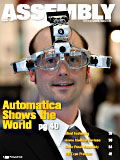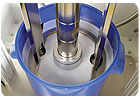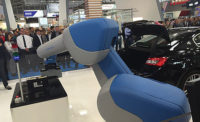
Some 30,642 manufacturing engineers and managers from 113 countries attended Automatica 2010, which took place June 8-11 at the New Munich Trade Fair Centre in Germany.
Held every two years, this international trade fair brings together all areas of robotics, mechatronics and automation under one roof. Some 708 exhibitors from 42 countries displayed their wares across 44,000 square meters of exhibition space.
One of those exhibitors was Deprag Inc., a supplier of manual, semiautomatic and fully automatic screwdriving systems. Among other products, Deprag displayed its new DCOS process control system. The DCOS is based on an industrial PC and works with Windows CE software. It can control complex motion sequences with cycle times of less than 6 milliseconds. It has a 6.5-inch color touch-screen display and two USB ports for connecting peripherals, such as a keyboard or mass storage device. The device can access the plant network or the World Wide Web via an EtherCat port.
Another Automatica exhibitor, Montech, displayed a variety of conveyors and modular automation components, such as grippers and actuators. The company introduced a new multitrack conveyor that can carry assemblies weighing up to 100 kilograms. The conveyor is available with flat or toothed belts, which can be spaced a maximum of 2,900 millimeters apart. Acceleration, deceleration and transport speed are adjustable. A fixed-speed model conveys products at speeds ranging from 0.5 to 56 meters per minute. The variable-speed model conveys products at speeds ranging from 0.13 to 113 meters per minute.
Plenty of systems integrators exhibited at Automatica, too. One of them, Ixmation Cox Systems, displayed a standard automated assembly cell called the Revolution. This modular, preconfigured cell was shown assembling a needle to a syringe. Fragile, razor-sharp needles are supplied from bulk, picked up by a gripper, and mounted atop a syringe.
The cell can accommodate a variety of custom handling and assembly devices, including robots, screwdrivers and dispensing equipment. For clean room applications, the cell can be made from stainless steel, and a HEPA filter and laminar air flow system can be installed.

The vacuum barrel follower plate from Scheugenpflug Inc. enables assemblers to feed highly viscous material out of its original container cleanly and without introducing air bubbles. Photo courtesy Scheugenpflug Inc.
Robots and Green Technology
While many conveyors, fastening machines and automated assembly systems were on display at Automatica, robots were the stars of the show.For example, researchers at Darmstadt University of Technology in Germany displayed the BioRob, a lightweight robot arm that not only moves like a human arm, it’s designed like one, too. The arm is powered by an electric motor that’s elastically coupled over wires to the joints, in much the same way that the human wrist and elbow are connected with muscles and tendons. The BioRob’s reach ranges from 0.5 to 0.9 meter, and it can carry a payload of 2 to 3 kilograms.
In spite of its flexible structure, the arm can perform high-precision movements without oscillations or overshooting. And, because of its passive compliance, the arm can safely operate side-by-side with people without need of additional safety precautions. The robot can be used for assembly, handling and service applications.
At its booth, IAI Corp. displayed a series of three-, four- and six-axis Cartesian robots. The X axis can be driven by linear motor or a ballscrew and servomotor. One four-axis system features two sliders along the X axis. Another four-axis system is equipped with a SCARA robot module as the vertical rotary axis. The robots can be integrated into high-speed automated assembly systems, or they can operate independently with one 230-volt connection and a PC. The work envelope measures 4,155 by 400 by 400 millimeters or 3,000 by 700 by 300 millimeters. The robots can carry payloads of 9 to 40 kilograms.
“Green Automation” was another major theme at Automatica, and exhibitors showed a variety of technologies designed to save energy and reduce waste on the assembly line.
For example, Schmalz Inc. brought its SMPi/SCPi vacuum ejector to the show. The SMPi/SCPi requires only 0.3 second of suction time to pick up a part. Vacuum generation stops as soon as a safe vacuum value has been reached. Vacuum generation is switched back on only if the suction level falls below a preset minimum value.
If the total cycle time to pick and place a part is 15 seconds, the SMPi/SCPi will be on 1.19 seconds per cycle, while a conventional vacuum ejector will be on 5.11 seconds. Over the course of a year, that difference could save an assembler 11,000 cubic meters of compressed air, or 65 percent less compressed air than a conventional model.
At its booth, dispensing equipment supplier Scheugenpflug Inc. displayed a product that eliminates the need to repackage bulk adhesives, which saves time and prevents waste. The company’s vacuum barrel follower plate enables assemblers to feed highly viscous material out of its original container cleanly and without introducing air bubbles.
The next Automatica show will take place June 12-15, 2012. For more information, visitwww.automatica-munich.com.

